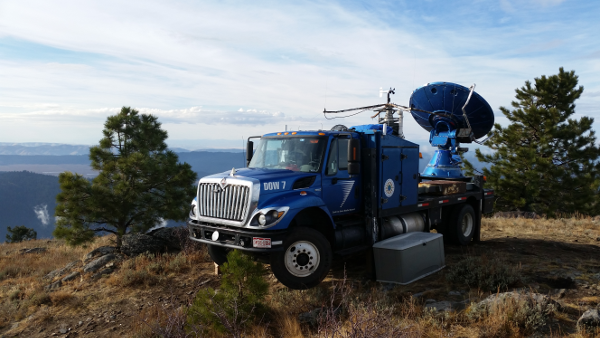

Background
In the winter, the Sawtooth Mountains of central Idaho are a pristine landscape with dense, snow-covered forests and medium-sized, snow-capped peaks. The mountain chain is part of the greater Rocky Mountains which cover the majority of central and northern Idaho. Winter snowstorms are heavily affected by mountainous terrain. Orographic lifting of moist surface air by dynamic flow over the mountains accelerates the growth of ice crystals in clouds, leading to enhanced snowfall. Every year, spring snowmelt from the Rocky Mountains provides irrigation for approximately 2 million acres of the Snake River Basin in the southern part of the state. Greater snowfall accumulation in the winter means more snowmelt provided for irrigation in the spring.
The concept of introducing silver iodide (AgI) into clouds to enhance rain or snowfall, a process called cloud seeding, was first developed in the 1940’s by meteorologists Vincent Shaeffer and Bernard Vonnegut. Enhancing snowfall through cloud seeding benefits farmers, skiers and snowmobilers, fish and wildlife, and most notably, hydroelectric plants which rely primarily on melting snow to generate power. The Idaho Power Company currently operates a large network of high-altitude, ground-based generators spread throughout the state, in addition to two cloud seeding aircraft. The program has been in operation since 2003, and has continued to expand ever since.
SNOWIE
Seeded Natural and Orographic Wintertime clouds – the Idaho Experiment (SNOWIE) is a comprehensive field campaign designed to address longstanding uncertainties regarding the effectiveness of orographic winter precipitation enhancement through cloud seeding. Researchers from multiple universities will participate in the project, together with the Idaho Power Company (IPC), the National Science Foundation (NSF), and the Center for Severe Weather Research (CSWR).
The project will take place near the Payette River Basin in the Sawtooth Mountains of central Idaho from January 7 to March 17, 2017. During the winter, the area is regularly assailed by orographically-enhanced snowstorms, and the IPC already has a network of cloud seeding ground generators set up in this area. Intensive observing periods (IOPs) will be centered around expected meteorological activity, with the guidance of weather forecasts from IPC and project personnel. During IOPs, cloud seeding with silver iodide will be conducted from either airborne or ground generators. The University of Wyoming King Air (UWKA) research aircraft, together with two permanently stationed Doppler-on-Wheels (DOW) mobile radars will observe the AgI plume and snowstorm as they are advected through the region. Additionally, teams of scientists and students will be stationed throughout the region to launch weather balloons, collect disdrometer data, and make general weather observations. For a more in-depth look at the scientific platforms and instruments that will used during SNOWIE, please see the Instruments section.
SNOWIE will seek to answer a number of relevant scientific questions:
1.) What is the role of mesoscale and microscale dynamics and of the underlying terrain in the formation, growth, and fallout of natural ice crystals in winter storms?
2.) How are natural snow growth processes altered as a result of airborne seeding with silver iodide?
3.) How are natural snow growth processes altered as a result of seeding from ground-based generators?
The field phase begins on January 7 so please follow this page for updates on SNOWIE! Be sure to view our Gallery, or keep up-to-date with mission operations at the SNOWIE Field Catalog.
Mission Summaries
- IOP01 (01/08/2017): Chief Scientist's Summary
- IOP02 (01/09/2017): Chief Scientist's Summary
- IOP03 (01/11/2017): Chief Scientist's Summary
- IOP04 (01/18/2017): Chief Scientist's Summary
- IOP05 (01/19/2017): Chief Scientist's Summary
- IOP06 (01/20/2017): Chief Scientist's Summary
- IOP07 (01/21/2017): Chief Scientist's Summary
- IOP08 (01/22/2017): Chief Scientist's Summary
- IOP09 (01/31/2017): Chief Scientist's Summary
- IOP10 (02/03/2017): Chief Scientist's Summary
- IOP11 (02/04/2017): Chief Scientist's Summary
- IOP12 (02/07/2017): Chief Scientist's Summary
- IOP13 (02/17/2017): Chief Scientist's Summary
- IOP14 (02/19/2017): Chief Scientist's Summary
- IOP15 (02/19/2017): Chief Scientist's Summary
- IOP16 (02/20/2017): Chief Scientist's Summary
- IOP17 (02/21/2017): Chief Scientist's Summary
- IOP18 (02/22/2017): Chief Scientist's Summary